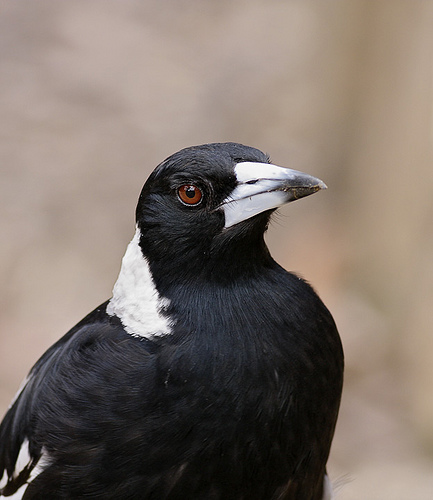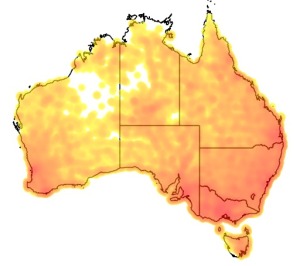
©Leo: Juvenile Australian Magpie (Gymnorhina tibicen) on the lawns near Old Parliament House in Canberra
Colours
Distinguishing features
Its robust wedge-shaped bill is bluish-white bordered with black, with a small hook at the tip. The black legs are long and strong.
The plumage is pure glossy black and white; both sexes of all subspecies have black heads, wings and underparts with white shoulders. The tail has a black terminal band. The nape is white in the male and light greyish-white in the female.
Mature magpies have dull reddish-brown eyes, in contrast to the yellow eyes of currawongs and white eyes of Australian ravens and crows.
The main difference between the subspecies lies in the "saddle" markings on the back below the nape. Black-backed subspecies have a black saddle and white nape. White-backed subspecies have a wholly white nape and saddle. The male Western Australian subspecies dorsalis is also white-backed, but the equivalent area in the female is scalloped black.
Juveniles have lighter greys and browns amidst the starker blacks and whites of their plumage; two or three year old birds of both sexes closely resemble and are difficult to distinguish from adult females.
Immature birds have dark brownish eyes until around two years of age. (Wikipedia)
Size
- From 36 cm to 44 cm (Length of specimen)
Wingspan
- From 65 cm to 85 cm
Synonyms
Interesting facts
- It can mimic over 35 species of native and introduced bird species, as well as dogs and horses. They have even been noted to mimic human speech when living in close proximity to humans. This mimicry is done in sub-vocalisation so you have to be listening carefully to hear it. (Wikipedia)
Distribution
Distribution and habitat preferences
The Australian Magpie prefers open areas such as grassland, fields and residential areas such as parks, gardens, golf courses, and streets, with scattered trees or forest nearby. Birds nest and shelter in trees but forage mainly on the ground in these open areas. (Wikipedia)
Audio recordings
Juvenile begging at Wyperfeld National Park (near Yaapeet), Victoria in Australia
© Marc Anderson
(source)
Warbling song at Wyperfeld National Park (near Yaapeet), Victoria in Australia
© Marc Anderson
(source)
Short calls at Royal National Park (near Lilyvale), New South Wales in Australia
© Marc Anderson
(source)
Diet
It is omnivorous, eating various items located at or near ground level including invertebrates such as earthworms, millipedes, snails, spiders and scorpions as well as a wide variety of insects—cockroaches, ants, beetles, moths and caterpillars and other larvae. Skinks, frogs, mice and other small animals as well as grain, tubers, figs and walnuts have also been noted as components of their diet. It has even learnt to safely eat the poisonous cane toad by flipping it over and consuming the underparts. Predominantly a ground feeder, the Australian Magpie paces open areas methodically searching for insects and their larvae.
One study showed birds were able to find scarab beetle larvae by sound or vibration. Birds use their bills to probe into the earth or otherwise overturn debris in search of food. Smaller prey are swallowed whole, although magpies rub off the stingers of bees and wasps before swallowing.
Web resources
Danger
- mild discomfort - Magpies are ubiquitous in urban areas all over Australia, and have become accustomed to people. A small percentage of birds become highly aggressive during breeding season from late August to early October, and will swoop and sometimes attack passersby. The percentage has been difficult to estimate but is significantly less than 9%. Almost all attacking birds (around 99%) are male, and they are generally known to attack pedestrians at around 50 m from their nest, and cyclists at around 100 m. Attacks begin as the eggs hatch, increase in frequency and severity as the chicks grow, and tail off as the chicks leave the nest. (Wikipedia)



